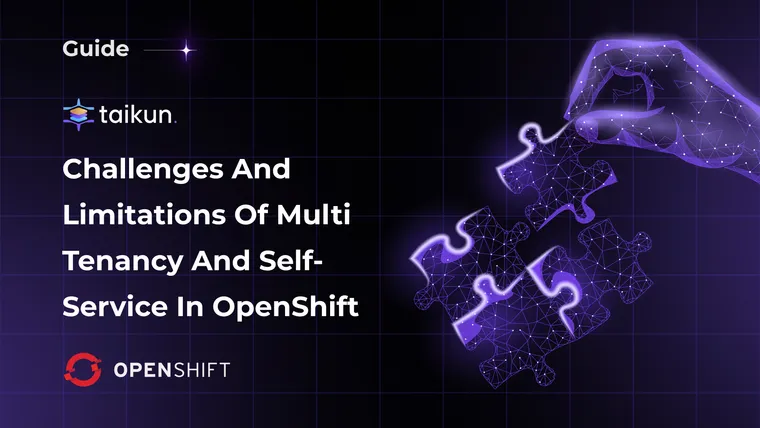OpenShift has quickly emerged as a powerful solution in the ever-evolving landscape of cloud computing and container orchestration, providing agile, scalable solutions to organizations seeking agility and scalability.
However, as its adoption increases so does its complexity in terms of managing multi-tenancy and self-service capabilities, which presents numerous challenges to organizations when trying to navigate shared environments or user-driven services.
This blog discusses the challenges and limitations of multi-tenancy and self-service in OpenShift.
Understanding Multi-Tenancy in OpenShift
A key feature of OpenShift, multi-tenancy allows organizations to share a single cluster among multiple users or teams in order to optimize resource usage and reduce costs while at the same time maximizing cost efficiency. Although multi-tenancy offers many advantages, there can also be challenges associated with it that must be carefully considered before taking advantage of any benefits it brings.
Isolation Issues:
Multi-tenancy’s primary challenge lies in isolating tenants from each other. Containers belonging to multiple users or teams all sharing the same infrastructure increase the risk of resource contention, security vulnerabilities, and performance degradation, thus necessitating robust isolation mechanisms to avoid scenarios in which actions taken by one tenant adversely impact others.
Resource Allocation and Fairness:
Resource allocation in multi-tenant environments can be tricky business. Finding an equitable distribution while preventing resource hogging or starvation takes intricate policies and tools; OpenShift provides resource quotas and limits, but fine-tuning them to accommodate diverse workloads across tenants may prove challenging.
Security Implications:
IT security is of utmost importance in any IT environment, and multi-tenancy can pose unique security challenges. Sharing resources increases attack surfaces significantly, so stringent access controls, network policies, and container security measures must be put into place immediately to reduce attack surface area and mitigate attack surface attacks. Regular audits and vulnerability assessments can identify any security loopholes and provide solutions.
Cost Management:
Multi-tenancy requires meticulous cost tracking and accounting to ensure each tenant bears their fair share of resource consumption. Granular metering and billing systems are essential for transparency and fairness.
Monitoring and Alerting:
Keeping a watchful eye on the entire cluster becomes crucial in a multi-tenant environment. Effective monitoring tools and unified alerting systems are necessary to identify and address issues affecting any tenant quickly.
Understanding Self-Service in OpenShift
OpenShift’s self-service capabilities empower users to deploy, scale, and manage their applications independently, reducing the burden on administrators. However, this autonomy comes with its own set of challenges and limitations.
Resource Governance:
While self-service encourages agility, it also raises concerns about resource governance. Users might unknowingly or intentionally deploy resource-intensive applications, leading to overutilization of resources and impacting the overall cluster performance. Striking a balance between autonomy and resource governance requires well-defined policies and monitoring mechanisms.
Complexity of Service Catalogs:
OpenShift’s service catalogs enable users to access predefined services easily. However, managing and curating a comprehensive catalog that meets the diverse needs of different tenants can be challenging. Ensuring that the catalog remains up-to-date, relevant, and secure requires continuous effort and coordination.
Cost Control:
Without proper cost controls in place, self-service users might unintentionally overspend on resources. Implementing spending limits and budget alerts helps ensure responsible resource utilization.
Learning Curve for Users:
Empowering users with self-service capabilities implies providing them with the necessary tools and documentation. However, the complexity of OpenShift and its features may pose a steep learning curve for users, particularly those unfamiliar with container orchestration. Adequate training and documentation become essential to maximize the benefits of self-service.
Mitigating Challenges and Overcoming Limitations
Addressing the challenges and limitations of multi-tenancy and self-service in OpenShift requires a holistic approach that combines technological solutions, best practices, and organizational strategies.
Fine-Tuning Resource Quotas and Limits:
Organizations must invest time in understanding the resource requirements of different tenants and applications. Fine-tuning resource quotas and limits based on actual usage patterns helps prevent resource contention and ensures fair distribution.
Implementing Robust Security Practices:
Security should be ingrained in every layer of the OpenShift environment. Implementing network policies, role-based access controls (RBAC), and regular security audits help mitigate risks associated with multi-tenancy. Organizations should stay vigilant about emerging threats and update security measures accordingly.
Automated Monitoring and Alerting Systems:
Proactive monitoring and alerting systems play an invaluable role in detecting issues before they have an adverse impact on overall performance. Utilizing automated tools that track resource usage, detect anomalies, and provide real-time insight empowers administrators to maintain a healthy multi-tenant environment.
Running OpenShift on OpenShift
OoO allows you to create isolated OpenShift clusters within a single master domain. This provides a clear separation of resources and governance for each tenant, reducing resource hogging, security risks, and compliance concerns. OoO creates separate security boundaries for each tenant cluster, reducing the risk of lateral movement of threats or unauthorized access across tenant environments. This strengthens the overall security posture and simplifies compliance compliance.
Education and Onboarding:
To overcome the learning curve associated with self-service, organizations should invest in comprehensive training programs and user-friendly documentation. Simplifying onboarding helps users quickly familiarize themselves with OpenShift’s capabilities while decreasing the chances of errors and encouraging responsible use.
Conclusion
As organizations embrace OpenShift as a container orchestrator, its limitations of multi-tenancy and self-service become apparent. Striking an optimal balance between flexibility and control, agility and governance takes a concerted effort from both administrators and users; by understanding and meeting these challenges head-on organizations can maximize OpenShift’s full potential while creating a secure, efficient, scalable container orchestration environment.


